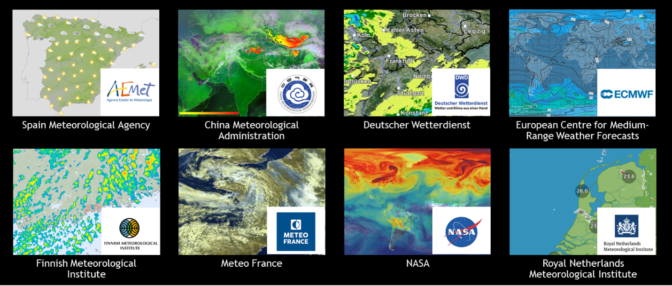Think of weather forecasting and satellite images on the local news probably come to mind. But another technology has transformed the task of forecasting and simulating the weather: supercomputing.
Weather and climate models are both compute and data intensive. Forecast quality depends on model complexity and high resolution. Resolution depends on the performance of supercomputers. And supercomputer performance depends on interconnect technology to move data quickly, effectively and in a scalable manner across compute resources.
That’s why many of the world’s leading meteorological services have chosen NVIDIA Mellanox InfiniBand networking to accelerate their supercomputing platforms, including the Spanish Meteorological Agency, the China Meteorological Administration, the Finnish Meteorological Institute, NASA and the Royal Netherlands Meteorological Institute.
The technological advantages of InfiniBand have made it the de facto standard for climate research and weather forecasting applications, delivering higher performance, scalability and resiliency versus any other interconnect technologies.
The Beijing Meteorological Service has selected 200 Gigabit HDR InfiniBand interconnect technology to accelerate its new supercomputing platform, which will be used for enhancing weather forecasting, improving climate and environmental research, and serving the weather forecasting information needs of the 2022 Winter Olympics in Beijing.
Meteo France, the French national meteorological service, has selected HDR InfiniBand to accelerate its two new large-scale supercomputers. The agency provides weather forecasting services for companies in transport, agriculture, energy and many other industries, as well as for a large number of media channels and worldwide sporting and cultural events. One of the systems debuted on the TOP500 list, out this month.
“We have been using InfiniBand for many years to connect our supercomputing platforms in the most efficient and scalable way, enabling us to conduct high-performance weather research and forecasting simulations,” said Alain Beuraud, HPC project manager at Meteo France. “We are excited to leverage the HDR InfiniBand technology advantages, its In-Network Computing acceleration engines, extremely low latency, and advanced routing capabilities to power our next supercomputing platforms.”
HDR InfiniBand will also accelerate the new supercomputer for the European Center for Medium Range Weather Forecasts (ECMWF). Being deployed this year, the system will support weather forecasting and prediction researchers from over 30 countries across Europe. It will increase the center’s weather and climate research compute power by 5x, making it one of the world’s most powerful meteorological supercomputers.
The new platform will enable running nearly twice as many higher-resolution probabilistic weather forecasts in less than an hour, improving the ability to monitor and predict increasingly severe weather phenomena and enabling European countries to better protect lives and property.
“We require the best supercomputing power and the best technologies available for our numerical weather prediction activities,” said Florence Rabier, director general at ECMWF. “With our new supercomputing capabilities, we will be able to run higher resolution forecasts in under an hour and enable much improved weather forecasts.”
“As governments and society continue to grapple with the impacts of increasingly severe weather, we are also proud to be relying on a supercomputer designed to maximize energy efficiency,” he added.
The NVIDIA Mellanox networking technology team has also been working with the German Climate Computing Centre on optimizing performance of the ICON application, the first project in a multi-phase collaboration. ICON is a unified weather forecasting and climate model, jointly developed by the Max-Planck-Institut für Meteorologie and Deutscher Wetterdienst (DWD), the German National Meteorological Service.
By optimizing the application’s data exchange modules to take advantage of InfiniBand, the team has demonstrated a nearly 20 percent increase in overall application performance.
The design of InfiniBand rests on four fundamentals: a smart endpoint design that can run all network engines; a software-defined switch network designed for scale; centralized management that lets the network be controlled and operated from a single place; and standard technology, ensuring forward and backward compatibility, with support for open source technology and open APIs.
It’s these fundamentals that help InfiniBand provide the highest network performance, extremely low latency and high message rate. As the only 200Gb/s high-speed interconnect in the market today, InfiniBand delivers the highest network efficiency with advanced end-to-end adaptive routing, congestion control and quality of service.
The forecast calls for more world-leading weather and climate agencies to announce their new supercomputing platforms this year using HDR InfiniBand. In the meantime, learn more about NVIDIA Mellanox InfiniBand HPC technology.

